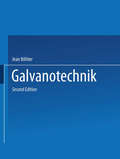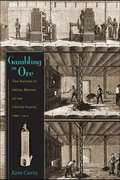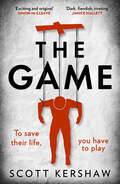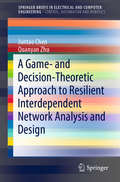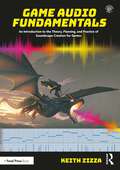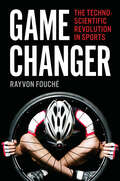- Table View
- List View
Galvin - Economic Inequality and Energy Consumption in Developed Countries: How Extremes of Wealth and Poverty in High Income Countries Affect CO2 Emissions and Access to Energy
by Ray GalvinInequality and Energy: How Extremes of Wealth and Poverty in High Income Countries Affect CO2 Emissions and Access to Energy challenges energy consumption researchers in developed countries to reorient their research frameworks to include the effects of economic inequality within the scope of their investigations, and calls for a new set of paradigms for energy consumption research. The book explores concrete examples of energy deprivation due to inequality, and provides conceptual tools to explore this in relation to other issues regarding energy consumption. It thereby urges that energy consumption approaches be updated for a world of increasing inequality. Extreme economic inequality has increased within developed countries over the past three decades. The effects of inequality are now seen increasingly in health, housing affordability, crime and social cohesion. There are signs it may even threaten democracy. Researchers are also exploring its effects on energy consumption. One of their key findings is that less privileged groups have lost consistent access to basic energy services like warm homes and affordable transport, leading to huge disparities of climate damaging emissions between rich and poor. - Provides overwhelming evidence of the persistent and increasing income inequality and wealth inequality in developed countries over the past three decades - Showcases recent empirical work that explores correlates of this inequality with energy consumption behavior and some of the key problems of access to adequate energy services - Shows the connections between these findings and the existing ways of researching energy consumption behavior and policy
Gambling Man: The Wild Ride of Japan’s Masayoshi Son
by Lionel BarberGambling Man is the biography of one of the world’s least known but most consequential investors.Japan’s Masayoshi Son has made and lost several fortunes, investing or controlling assets worth $1 trillion in the past two decades through his media-tech giant, SoftBank. He bankrolled Alibaba, China’s internet colossus, before the world had heard about it; plotted with Steve Jobs to turn the iPhone into a wonder product; and financed hundreds of tech start-ups, fuelling the biggest boom Silicon Valley has ever seen. This book takes you on Son’s wild ride, from his birthplace in a Korean slum in post-war Japan to the modern-day temples of power. It speeds through Donald Trump’s golden skyscraper in Manhattan, the royal palaces of Riyadh and the throne rooms of China’s Marxist rulers; all places where Son has deployed his unique blend of financial engineering and crazy risk-taking. Son’s story captures a 25 year-span of hyper-globalisation in which money, technologies and ideas flowed freely. From the launch of the microchip to the advent of artificial intelligence, he has ridden the technological wave which has created extraordinary wealth and economic change. His topsy-turvy business career is testimony to the power of optimism, daring to dream, ever in search of the Next Big Thing. As an ethnic Korean in Japan, Son has overcome adversity and discrimination to become Japan’s best-known businessman and empire-builder but he remains an elusive, intensely private figure. This book, by a former editor of the Financial Times, contains a wealth of new information and has had the co-operation of many of the key participants, including Son himself. Written with a verve appropriate to its subject, Gambling Man reveals the man behind the money, what drives him, why he matters, and what he plans for his next act.
Gambling on Ore: The Nature of Metal Mining in the United States, 1860–1910 (Mining the American West)
by Kent CurtisGambling on Ore examines the development of the western mining industry from the tumultuous and violent Gold Rush to the elevation of large-scale copper mining in the early twentieth century, using Montana as representative of mining developments in the broader US mining west. Employing abundant new historical evidence in key primary and secondary sources, Curtis tells the story of the inescapable relationship of mining to nature in the modern world as the United States moved from a primarily agricultural society to a mining nation in the second half of the nineteenth century. In Montana, legal issues and politics—such as unexpected consequences of federal mining law and the electrification of the United States—further complicated the mining industry’s already complex relationship to geology, while government policy, legal frameworks, dominant understandings of nature, and the exigencies of profit and production drove the industry in momentous and surprising directions. Despite its many uncertainties, mining became an important part of American culture and daily life. Gambling on Ore unpacks the tangled relationships between mining and the natural world that gave material possibility to the age of electricity. Metal mining has had a profound influence on the human ecology and the social relationships of North America through the twentieth century and throughout the world after World War II. Understanding how we forged these relationships is central to understanding the environmental history of the United States after 1850.
The Game
by Scott KershawTo save their life, you have to play. ‘Exciting and original’ Simon McCleave‘Dark, fiendish, riveting’ Janice Hallett‘This year’s must-read thriller’ Adam Croft___
A Game- and Decision-Theoretic Approach to Resilient Interdependent Network Analysis and Design (SpringerBriefs in Electrical and Computer Engineering)
by Juntao Chen Quanyan ZhuThis brief introduces game- and decision-theoretical techniques for the analysis and design of resilient interdependent networks. It unites game and decision theory with network science to lay a system-theoretical foundation for understanding the resiliency of interdependent and heterogeneous network systems. The authors pay particular attention to critical infrastructure systems, such as electric power, water, transportation, and communications. They discuss how infrastructure networks are becoming increasingly interconnected as the integration of Internet of Things devices, and how a single-point failure in one network can propagate to other infrastructures, creating an enormous social and economic impact. The specific topics in the book include: · static and dynamic meta-network resilience game analysis and design; · optimal control of interdependent epidemics spreading over complex networks; and · applications to secure and resilient design of critical infrastructures. These topics are supported by up-to-date summaries of the authors’ recent research findings. The authors then discuss the future challenges and directions in the analysis and design of interdependent networks and explain the role of multi-disciplinary research has in computer science, engineering, public policy, and social sciences fields of study. The brief introduces new application areas in mathematics, economics, and system and control theory, and will be of interest to researchers and practitioners looking for new approaches to assess and mitigate risks in their systems and enhance their network resilience. A Game- and Decision-Theoretic Approach to Resilient Interdependent Network Analysis and Design also has self-contained chapters, which allows for multiple levels of reading by anyone with an interest in game and decision theory and network science.
Game Audio Fundamentals: An Introduction to the Theory, Planning, and Practice of Soundscape Creation for Games
by Keith ZizzaGame Audio Fundamentals takes the reader on a journey through game audio design: from analog and digital audio basics to the art and execution of sound effects, soundtracks, and voice production, as well as learning how to make sense of a truly effective soundscape. Presuming no pre-existing knowledge, this accessible guide is accompanied by online resources – including practical examples and incremental DAW exercises – and presents the theory and practice of game audio in detail, and in a format anyone can understand. This is essential reading for any aspiring game audio designer, as well as students and professionals from a range of backgrounds, including music, audio engineering, and game design.
Game Audio Fundamentals: An Introduction to the Theory, Planning, and Practice of Soundscape Creation for Games
by Keith ZizzaGame Audio Fundamentals takes the reader on a journey through game audio design: from analog and digital audio basics to the art and execution of sound effects, soundtracks, and voice production, as well as learning how to make sense of a truly effective soundscape. Presuming no pre-existing knowledge, this accessible guide is accompanied by online resources – including practical examples and incremental DAW exercises – and presents the theory and practice of game audio in detail, and in a format anyone can understand. This is essential reading for any aspiring game audio designer, as well as students and professionals from a range of backgrounds, including music, audio engineering, and game design.
Game Audio Mixing: Insights to Improve Your Mixing Performance
by Alex RiviereGame Audio Mixing offers a holistic view of the mixing process for games, from philosophical and psychological considerations to the artistic considerations and technical processes behind acoustic rendering, interactive mixing, mastering, and much more. This book includes a comprehensive overview of many game audio mixing techniques, processes, and workflows, with advice from audio directors and sound supervisors. Through a series of accessible insights and interviews, the reader is guided through cutting-edge tips and tricks to equip them to improve their own mixing practice. As well as covering how to plan and create a mix that is clear, focused, and highly interactive, this book provides information about typical mixing tools and techniques, such as dealing with bus structure, frequency spectrum, effects, dynamic, volume, 2D and 3D spaces, and automations. Key information about how to deal with a large number of sounds and their prioritization in the mix is also included, from high-level mixing visions to in-depth designs with sound categorizations at the core. Game Audio Mixing is essential reading for all game audio professionals, including those new to the industry, as well as experienced professionals working on AAA and indie titles, in addition to aspiring professionals and hobbyists.
Game Audio Mixing: Insights to Improve Your Mixing Performance
by Alex RiviereGame Audio Mixing offers a holistic view of the mixing process for games, from philosophical and psychological considerations to the artistic considerations and technical processes behind acoustic rendering, interactive mixing, mastering, and much more. This book includes a comprehensive overview of many game audio mixing techniques, processes, and workflows, with advice from audio directors and sound supervisors. Through a series of accessible insights and interviews, the reader is guided through cutting-edge tips and tricks to equip them to improve their own mixing practice. As well as covering how to plan and create a mix that is clear, focused, and highly interactive, this book provides information about typical mixing tools and techniques, such as dealing with bus structure, frequency spectrum, effects, dynamic, volume, 2D and 3D spaces, and automations. Key information about how to deal with a large number of sounds and their prioritization in the mix is also included, from high-level mixing visions to in-depth designs with sound categorizations at the core. Game Audio Mixing is essential reading for all game audio professionals, including those new to the industry, as well as experienced professionals working on AAA and indie titles, in addition to aspiring professionals and hobbyists.
The Game Audio Strategy Guide: A Practical Course
by Gina Zdanowicz Spencer BambrickThe Game Audio Strategy Guide is a comprehensive text designed to turn both novices and experienced audio designers into technical game audio pros. Providing both a theoretical foundation and practical insights, The Game Audio Strategy Guide offers a thorough look at the tools and methods needed to create industry-quality music and sound design for games. The text is supported by an extensive companion website, featuring numerous practical tutorials and exercises, which allows the reader to gain hands-on experience creating and implementing audio assets for games. The Game Audio Strategy Guide is the essential manual for anyone interested in creating audio for games, inside or outside the classroom.
The Game Audio Strategy Guide: A Practical Course
by Gina Zdanowicz Spencer BambrickThe Game Audio Strategy Guide is a comprehensive text designed to turn both novices and experienced audio designers into technical game audio pros. Providing both a theoretical foundation and practical insights, The Game Audio Strategy Guide offers a thorough look at the tools and methods needed to create industry-quality music and sound design for games. The text is supported by an extensive companion website, featuring numerous practical tutorials and exercises, which allows the reader to gain hands-on experience creating and implementing audio assets for games. The Game Audio Strategy Guide is the essential manual for anyone interested in creating audio for games, inside or outside the classroom.
Game Audio with FMOD and Unity
by Ciarán RobinsonGame Audio with FMOD and Unity introduces readers to the principles and practice of game audio through the process of creating their own First Person Shooter (FPS) game. All the basics are covered, as well as a simple introduction to coding. Using the free software Unity and FMOD Audio Middleware, the reader will be able to create a game of their own and develop a portfolio that demonstrates their capacities in interactive sound design. Perfect for classroom use or independent study, Game Audio with FMOD and Unity also comes with a full suite of audio assets provided on a companion website.
Game Audio with FMOD and Unity
by Ciarán RobinsonGame Audio with FMOD and Unity introduces readers to the principles and practice of game audio through the process of creating their own First Person Shooter (FPS) game. All the basics are covered, as well as a simple introduction to coding. Using the free software Unity and FMOD Audio Middleware, the reader will be able to create a game of their own and develop a portfolio that demonstrates their capacities in interactive sound design. Perfect for classroom use or independent study, Game Audio with FMOD and Unity also comes with a full suite of audio assets provided on a companion website.
Game-Based Assessment Revisited (Advances in Game-Based Learning)
by Dirk Ifenthaler Yoon Jeon KimThe capabilities and possibilities of emerging game-based learning technologies bring about a new perspective of learning and instruction. This, in turn, necessitates alternative ways to assess the kinds of learning that are taking place in the game-based environments. The field has been broadening the focus of assessment in game environments (i.e., what we measure), developing processes and methodologies that go beyond psychometrics practices (i.e., how we go about assessment in games), and implementing the game-based assessment (GBA) in real contexts. The current state of the field calls for a revisit of this topic to understand what we have learned from the research on this topic, and how the GBA work changed how the field thinks about assessment beyond game environments. Accordingly, this comprehensive volume covers the current state of research, methodology, and technology of game-based assessment. It features four major themes: what we are measuring in games, how GBA has influenced how people do assessment beyond games, new methods and practices, and implementations of GBA. The audience for this volume includes researchers, graduate students, teachers, and professional practitioners in the areas of education, instructional design, educational psychology, academic and organizational development, and instructional technology.
Game-Based Learning Across the Lifespan: Cross-Generational and Age-Oriented Topics (Advances in Game-Based Learning)
by Margarida Romero Kimberly Sawchuk Josep Blat Sergio Sayago Hubert OuelletThe book provides a systemic view of the state-of-the- art of Digital Game Based Learning (DGBL) across the lifespan, from age-specific game design requirements to technological devices that could overcome child and older adult difficulties in the use of DGBL technologies. Other topics include cross-generational digital game-based learning, workplace gaming, exergaming, serious games to tackle societal challenges,and implications of DGBL across the lifespan for game designers.In addition to the state-of-the-art methodologies provided for age-specific gamedesign, development, implementation and assessment, a significant portion of the book focuses on case studies where DGBL have been designed and implemented in every age groups and in cross-generational situations.
Game Changer: The Technoscientific Revolution in Sports
by Rayvon FouchéWe like to think of sports as elemental: strong bodies trained to overcome height, weight, distance; the thrill of earned victory or the agony of defeat in a contest decided on a level playing field. But in Game Changer, Rayvon Fouché argues that sports have been radically shaped by an explosion of scientific and technological advances in materials, training, nutrition, and medicine dedicated to making athletes stronger and faster. Technoscience, as Fouché dubs it, increasingly gives the edge (however slight) to the athlete with the latest gear, the most advanced training equipment, or the performance-enhancing drugs that are hardest to detect. In this revealing book, Fouché examines a variety of sports paraphernalia and enhancements, from fast suits, athletic shoes, and racing bicycles to basketballs and prosthetic limbs. He also takes a hard look at gender verification testing, direct drug testing, and the athlete biological passport in an attempt to understand the evolving place of technoscience across sport. In this book, Fouché: • Examines the relationship among sport, science, and technology• Considers what is at stake in defining sporting culture by its scientific knowledge and technology• Provides readers and students with an informative and engagingly written studyFocusing on well-known athletes, including Michael Phelps, Oscar Pistorius, Caster Semenya, Usain Bolt, and Lance Armstrong, Fouché argues that technoscience calls into question the integrity of games, records, and our bodies themselves. He also touches on attempts by sporting communities to regulate the use of technology, from elite soccer's initial reluctance to utilize goal-line technology to automobile racing's endless tweaking of regulatory formulas in an attempt to blur engineering potency and reclaim driver skill and ability. Game Changer will change the way you look at sportsâ€�and the outsized impact technoscience has on them.
Game Changer: The Technoscientific Revolution in Sports
by Rayvon FouchéWe like to think of sports as elemental: strong bodies trained to overcome height, weight, distance; the thrill of earned victory or the agony of defeat in a contest decided on a level playing field. But in Game Changer, Rayvon Fouché argues that sports have been radically shaped by an explosion of scientific and technological advances in materials, training, nutrition, and medicine dedicated to making athletes stronger and faster. Technoscience, as Fouché dubs it, increasingly gives the edge (however slight) to the athlete with the latest gear, the most advanced training equipment, or the performance-enhancing drugs that are hardest to detect. In this revealing book, Fouché examines a variety of sports paraphernalia and enhancements, from fast suits, athletic shoes, and racing bicycles to basketballs and prosthetic limbs. He also takes a hard look at gender verification testing, direct drug testing, and the athlete biological passport in an attempt to understand the evolving place of technoscience across sport. In this book, Fouché: • Examines the relationship among sport, science, and technology• Considers what is at stake in defining sporting culture by its scientific knowledge and technology• Provides readers and students with an informative and engagingly written studyFocusing on well-known athletes, including Michael Phelps, Oscar Pistorius, Caster Semenya, Usain Bolt, and Lance Armstrong, Fouché argues that technoscience calls into question the integrity of games, records, and our bodies themselves. He also touches on attempts by sporting communities to regulate the use of technology, from elite soccer's initial reluctance to utilize goal-line technology to automobile racing's endless tweaking of regulatory formulas in an attempt to blur engineering potency and reclaim driver skill and ability. Game Changer will change the way you look at sportsâ€�and the outsized impact technoscience has on them.
Game Design Deep Dive: Role Playing Games
by Joshua BycerGame Design Critic Josh Bycer is back with another entry in the Game Design Deep Dive series to discuss the Role-Playing Game genre. Arguably one of the most recognizable in the industry today, what is and what isn’t an RPG has changed over the years. From the origins in the tabletop market, to now having its design featured all over, it is one of the most popular genres to draw inspiration from and build games around. This is a genre that looks easy from the outside to make, but requires understanding a variety of topics to do right. • A breakdown of RPG mechanics and systems, perfect for anyone wanting to study or make one themselves • The history of the genre – from tabletop beginnings to its worldwide appeal • The reach of the genre – a look at just some of the many different takes on RPGs that have grown over the past 40 years • An examination of how RPG systems can be combined with other designs to create brand new takes
Game Design Deep Dive: Role Playing Games
by Joshua BycerGame Design Critic Josh Bycer is back with another entry in the Game Design Deep Dive series to discuss the Role-Playing Game genre. Arguably one of the most recognizable in the industry today, what is and what isn’t an RPG has changed over the years. From the origins in the tabletop market, to now having its design featured all over, it is one of the most popular genres to draw inspiration from and build games around. This is a genre that looks easy from the outside to make, but requires understanding a variety of topics to do right. • A breakdown of RPG mechanics and systems, perfect for anyone wanting to study or make one themselves • The history of the genre – from tabletop beginnings to its worldwide appeal • The reach of the genre – a look at just some of the many different takes on RPGs that have grown over the past 40 years • An examination of how RPG systems can be combined with other designs to create brand new takes
Game Design for Free-to-Play Live Service (Synthesis Lectures on Image, Video, and Multimedia Processing)
by Stanislav Stanković"Game Design for Free to Play Live Service" is the ultimate guide to designing successful free-to-play mobile games. Based on a decade of experience at companies like Rovio, EA, and Supercell, the author provides practical advice on gameplay mechanics, monetization strategies, and player engagement. With case studies and expert insights, this book is essential reading for any game developer looking to create a hit mobile game.
Game Dev Stories Volume 1: Interviews About Game Development and Culture
by David L. CraddockGame Dev Stories: Interviews About Game Development and Culture Volumes 1 and 2 are a collection of interviews from renowned author David L. Craddock as he explores all corners of the video game industry. Collected from the author's archives, Game Dev Stories gathers conversations with individuals from all corners of the industry: Who they are, the paths they paved, and their contributions to this multibillion-dollar industry. This text offers viewpoints from well-known individuals like John Romero, Tom Hall, and Matt Householder. From artists and writers to programmers and designers, Game Dev Stories offers amazing insights and understanding to what occurs behind the screens of your favorite games and may help inspire future game developers in pursuing their dreams. Author Bio David L. Craddock writes fiction, nonfiction, and grocery lists. He is the author of over a dozen nonfiction books about video game development and culture, including the bestselling Stay Awhile and Listen series, Arcade Perfect: How Pac-Man, Mortal Kombat, and Other Coin-Op Classics Invaded the Living Room, and fiction for young adults, including The Dumpster Club and Heritage: Book One of the Gairden Chronicles. Find him online @davidlcraddock on Twitter.
Game Dev Stories Volume 1: Interviews About Game Development and Culture
by David L. CraddockGame Dev Stories: Interviews About Game Development and Culture Volumes 1 and 2 are a collection of interviews from renowned author David L. Craddock as he explores all corners of the video game industry. Collected from the author's archives, Game Dev Stories gathers conversations with individuals from all corners of the industry: Who they are, the paths they paved, and their contributions to this multibillion-dollar industry. This text offers viewpoints from well-known individuals like John Romero, Tom Hall, and Matt Householder. From artists and writers to programmers and designers, Game Dev Stories offers amazing insights and understanding to what occurs behind the screens of your favorite games and may help inspire future game developers in pursuing their dreams. Author Bio David L. Craddock writes fiction, nonfiction, and grocery lists. He is the author of over a dozen nonfiction books about video game development and culture, including the bestselling Stay Awhile and Listen series, Arcade Perfect: How Pac-Man, Mortal Kombat, and Other Coin-Op Classics Invaded the Living Room, and fiction for young adults, including The Dumpster Club and Heritage: Book One of the Gairden Chronicles. Find him online @davidlcraddock on Twitter.


